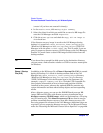
Disaster Recovery
Enhanced Automated Disaster Recovery of a Windows System
Chapter 10466
Certificate Server Database are not restored automatically during
Phase 2. They can be restored on the target system using the
standard Data Protector restore procedure.
Disk and Partition
Configuration
• With fault-tolerant disk drives on the OS level for Windows NT
systems, mirror set is supported while stripe and volume set are not.
Dynamic disks are not supported on Windows 2000 (including mirror
set upgraded from Windows NT).
• New disk has to be the same size or bigger than the crashed disk. If it
is larger than the original disk, the difference will remain
unallocated.
• Boot and system partition on Windows NT 4.0 must be physically
bellow the first 7,8 GB due to the operating system limitations. Refer
to MSDN Q224526.
• Only vendor specific partitions of type 0x12 (including EISA) and
0xFE are supported for Enhanced Automated Disaster Recovery.
Preparation
Complete the steps described in the section “Preparing for a Disaster
Recovery” on page 443 in order to prepare for disaster recovery in
addition to completing the steps listed in this section. See also “Advanced
Recovery Tasks” on page 490.
IMPORTANT You have to prepare for disaster recovery before a disaster occurs.
Prerequisite Full client backup (including the configuration) is prerequisite for
successful EADR. See “Backing Up Filesystems (Logical Disk Drives)” on
page 168 and “Backing Up CONFIGURATION” on page 173.
DR Image File Data required for temporary DR OS installation and configuration (DR
image) is packed in a single large file and stored on the backup medium
and optionally on the Cell Manager during a full client backup. If you
want to save the full disaster recovery image file to the Cell Manager for
all clients in the backup specification, perform the following steps:
1. In the Context List, select Backup.


















